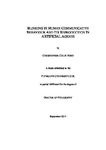Blinking in Human Communicative Behaviour and it's Reproduction in Artificial Agents
| dc.contributor.supervisor | Bugmann, Guido | |
| dc.contributor.author | Ford, Christopher Colin | |
| dc.contributor.other | Faculty of Science and Engineering | en_US |
| dc.date.accessioned | 2015-01-21T16:25:48Z | |
| dc.date.available | 2015-01-21T16:25:48Z | |
| dc.date.issued | 2014 | |
| dc.identifier | 273956 | en_US |
| dc.identifier.uri | http://hdl.handle.net/10026.1/3197 | |
| dc.description.abstract |
A significant year-on-year rise in the creation and sales of personal and domestic robotic systems and the development of online embodied communicative agents (ECAs) has in parallel seen an increase in end-users from the public domain interacting with these systems. A number of these robotic/ECA systems are defined as social, whereby they are physically designed to resemble the bodily structure of a human and behaviorally designed to exist within human social surroundings. Their behavioural design is especially important with respect to communication as it is commonly stated that for any social robotic/ECA system to be truly useful within its role, it will need to be able to effectively communicate with its human users. Currently however, the act of a human user instructing a social robotic/ECA system to perform a task highlights many areas of contention in human communication understanding. Commonly, social robotic/ECA systems are embedded with either non-human-like communication interfaces or deficient imitative human communication interfaces, neither of which reach the levels of communicative interaction expected by human users, leading to communication difficulties which in turn create negative association with the social robotic/ECA system in its users. These communication issues lead to a strong requirement for the development of more effective imitative human communication behaviours within these systems. This thesis presents findings from our research into human non-verbal facial behaviour in communication. The objective of the work was to improve communication grounding between social robotic/ECA systems and their human users through the conceptual design of a computational system of human non-verbal facial behaviour (which in human-human communicative behaviour is shown to carry in the range of 55% of the intended semantic meaning of a transferred message) and the development of a highly accurate computational model of human blink behaviour and a computational model of physiological saccadic eye movement in human-human communication, enriching the human-like properties of the facial non-verbal communicative feedback expressed by the social robotic/ECA system. An enhanced level of interaction would likely be achieved, leading to increased empathic response from the user and an improved chance of a satisfactory communicative conclusion to a user’s task requirement instructions. The initial focus of the work was in the capture, transcription and analysis of common human non-verbal facial behavioural traits within human-human communication, linked to the expression of mental communicative states of understanding, uncertainty, misunderstanding and thought. Facial Non-Verbal behaviour data was collected and transcribed from twelve participants (six female) through a dialogue-based communicative interaction. A further focus was the analysis of blink co-occurrence with other traits of human-human communicative non-verbal facial behaviour and the capture of saccadic eye movement at common proxemic distances. From these data analysis tasks, the computational models of human blink behaviour and saccadic eye movement behaviour whilst listening / speaking within human-human communication were designed and then implemented within the LightHead social robotic system. Human-based studies on the perception of naïve users of the imitative probabilistic computational blink model performance on the LightHead robotic system are presented and the results discussed. The thesis concludes on the impact of the work along with suggestions for further studies towards the improvement of the important task of achieving seamless interactive communication between social robotic/ECA systems and their human users. | en_US |
| dc.language.iso | en | en_US |
| dc.publisher | Plymouth University | en_US |
| dc.subject | Human Robot Interaction | en_US |
| dc.subject | Robotics | en_US |
| dc.subject | Human Communication | en_US |
| dc.subject | Non Verbal Communication | en_US |
| dc.subject | Human Behaviour | en_US |
| dc.subject | Blinking | en_US |
| dc.title | Blinking in Human Communicative Behaviour and it's Reproduction in Artificial Agents | en_US |
| dc.type | Thesis | |
| plymouth.version | Edited version | en_US |
| dc.identifier.doi | http://dx.doi.org/10.24382/3452 |
Files in this item
This item appears in the following Collection(s)
-
01 Research Theses Main Collection
Research Theses Main


